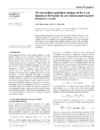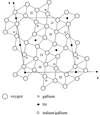issue contents
January 2003 issue

Cover illustration: Polyhedral representation of voids in the sodium-free sublattice of the crystal structure of NaAlSiO4 zeolite. See Blatov & Shevchenko [Acta Cryst. (2003). A59, 34-44].
research papers
A lamellar model was developed to predict the X-ray rocking curves of sagittally bent Laue crystals.
A generalization of the time-dependent Takagi–Taupin equation which covers also `optical phonon'-type distortions and its perturbative analytical solution for the case of single-mode phonons.
This paper presents scf-DFT calculations on α- and β-Ti2Se including full structural relaxation. The results serve to validate recent results from selected-area electron diffraction obtained for the previously unknown β structure.
Five regular nets and one quasiregular net are identified and described.
The use of the crystallographic symmetry as a new reliable criterion for the correctness of the phase extension process in the context of the TWIN variables algorithm.
The methods of the analysis of voids and cavities in crystal structures by means of Voronoi–Dirichlet polyhedra and of the graph theory are stated. The efficiency of the method is shown with the analysis of compounds of different chemical nature: simple substances, ionic structures, superionic conductors, zeolites, clathrates, organic supramolecular complexes.
The pendulum analogy has been generalized in a form suitable for the case of an off-Bragg position. It is shown that, by introducing a time variation of the pendula masses, this analogy can be used to simulate the X-ray dynamical diffraction by a one-dimensional regularly deformed crystal.
The concept of direct methods is developed one step further using both the two-dimensional ED and HRTEM data sets in a domino fashion. The idea of the domino phase-retrieval procedure is to obtain the phase fit for the complex structure factors sequentially from low- to high-order ED and HRTEM data sets.
A diffraction pattern for Penrose tiling has been calculated with the Gaussian approximation for the average unit cell. Analytical formulae have been derived and checked against numerical results.
The joint probability distribution of two-phase structure invariants (doublets) is derived. This distribution leads directly to a formula for estimating individual phases when a heavy-atom substructure is known.
international union of crystallography
Free 

Free 



 journal menu
journal menu































